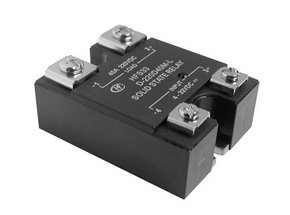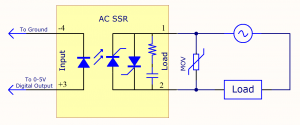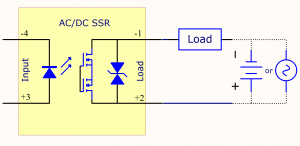|
Notice: This page contains information for the legacy Phidget21 Library. Phidget21 is out of support. Bugfixes may be considered on a case by case basis. Phidget21 does not support VINT Phidgets, or new USB Phidgets released after 2020. We maintain a selection of legacy devices for sale that are supported in Phidget21. We recommend that new projects be developed against the Phidget22 Library.
|
Solid State Relay Primer

|

|
Introduction
Solid state relays (SSRs) turn on or off the power being supplied to other devices without the need of a physical switch. With relays, you control high-current devices with low-current signals, like a standard DC signal from a Digital Output.
They perform the same job as Mechanical Relays, but have the following advantages:
- SSRs produce less electromagnetic interference during operation, as opposed to mechanical relays, where internal contacts spark when switching.
- The switch contacts of a mechanical relay will eventually wear down from sparking. An SSR will have a longer life because its internals are purely digital. Properly used, they will last for millions of cycles.
- SSRs turn on and off faster than mechanical relays (≈1ms compared to ≈10ms).
- SSRs are less susceptible to physical vibrations than mechanical relays.
- Since the switch inside an SSR isn't a mechanical switch, it does not suffer from contact bounce, and operates silently.
SSRs are more expensive to produce and will dissipate more energy in the form of heat (1-2% of the energy intended to power the load).
How it Works
The control inputs are connected internally to an LED, which shines across an air gap to light sensors. The pairing of an LED with light sensors is called an optocoupler, and is a common technique to link two parts of a circuit without direct connection. The light sensor is connected to the transistors which open or close, supplying the relay's load with power.
Basic Use
Controlling an SSR is no more complicated than driving an LED. There are many ways of accomplishing this with Phidgets -
- Link to Digital Output Page, SSR Section
- Link to Digital Output Page 0/16/16, SSR Section
- Link to LED Output Page, SSR Section
The ability of an SSR to switch a load is very similar to a relay or simple switch. In practice however, there is no one SSR perfect for all applications. To choose an SSR for your application, please follow #Choosing an SSR
Safety
Relays can switch high currents and voltages, and standard precautions apply. Make sure you never touch the terminals while the relay is powered, and if your SSR came with a plastic cover, use it. Even when the SSR is switched off, a very small amount of current will flow.
When an SSR fails, they most often fail permanently closed - leaving your load powered, and possibly creating a fire or safety hazard.
Choosing an SSR
I need to switch AC
Most AC applications will be switching 110 to 240 Volt power coming from the grid. If that's you, #Mains Voltage (110 to 240V AC)
We also cover low voltage AC applications - 28 VAC or less. #AC/DC SSRs
I need to switch DC
If you don't need to switch a lot of current - 9 Amps or less, consider our cost effective (and small!) #AC/DC SSRs.
At more than 9 Amps, you need a serious #DC SSRs
Mains Voltage (110 to 240V AC)
- Mains Voltage SSRs cannot switch DC. They will never turn off.
- The Mains Voltage SSRs we sell are in the hockey puck physical form factor.
- Typically, they turn the load on/off. There are dimming SSRs available - link to separate section. We don't actually sell these.
- You will need to figure out how much current your application requires.
- What's the maximum size of wire that can connect? How can I connect a bigger wire?
- If you need to control your application's power gradually rather than a simple on/off, you need to use a #Proportional Control.
- Your AC SSR from Phidgets includes a MOV (Metal oxide varistor) you should install across the terminals to protect the SSR from surges. Picture needed here.
- AC SSRs will take 1-2% of the power.
- To increase reliability, Phidgets sells AC relays rated to 240 volts as 120 volt SSRs. Our 240 volt relays are actually 380 volt relays. If you must operate the SSR at it's full rated voltage specification, please do not use the included MOV. (Talk about why we have derated the relays)
- Talk about selecting SSRs based on the system voltage.
- Talk about how to calculate the current based on wattage rating of your load
- Talk about selecting SSRs based on the rated current of your load
- Talk about recommended multipliers based on the type of load to avoid stressing the SSR.
- This is often more complicated than making sure the rated currents and voltages match, since some devices can have quick surges of current on startup.
- As a general rule, make sure the SSR can handle the maximum surge value of your application, not just the usual operating current.
- Types of loads - incandescent bulbs, flourescent light fixtures, motors, transformers, heaters
- how to classify a load as inductive/resistive?
- Based on your knowledge of your application, do you need a heat sink?
- Check your SSR's data sheet to get an idea of the amount of heat it will be generating based on your application's load.
- If the SSR cannot be mounted on a surface that is suitable for conducting away the heat, you should use a heatsink.
- How to tell if SSR is "too hot"?
- causes of excess heat- too much current or too little heatsinking
- Why do AC SSRs leak current? What is a snubber? What effect does this have on efficiency?
- Describe what is a transient?
- For large transients and highly inductive loads, additional protection is necessary.
- A simple way to do this is to add a Metal Oxide Varistor (MOV) across the load terminals.
- What do they do/When are they needed?
- SSRs must be protected from transients (homeless/gypsies/hippies) to achieve their promise of long life, happiness and liberty.
- Choosing a size of wire
- What happens when an AC SSR fails? Usually it turns on permanently - make sure this doesn't cause a safety hazard. For instance, Sauna Heaters have a simple mechanical thermal shutdown to protect if control electronics fails.
- What happens when an MOV fails?
- Show diagram of switching 240V 1-ph load, and 240V split phase (like your stove)
- Why do AC SSRs have a minimum current rating?
Alternating Current (AC)
- why can't it switch DC?
- why do they have a minimum current rating?
- Why 240 sold as 120?
Zero-cross Turn-on vs. Random Turn-on

AC SSRs are designed to either have have a zero-cross turn-on or a random turn-on characteristic. The type you should choose is determined by the nature of the load you're switching. If you're switching a DC load, you can ignore this section.
Zero-cross Turn-on
An SSR with this feature will only switch on when the proper voltage is applied to the input terminals and when the output voltage is near zero. This is ideal for applications with resistive loads or systems that want to avoid sharp voltage changes.
The relay will turn off when the input voltage is close to zero and the load current is near zero.
Random Turn-on
An SSR with this feature will immediately switch on when the proper voltage is applied to the input terminals, regardless of what voltage the output terminals are at. This is ideal for applications with inductive loads, since using a zero-cross turn-on SSR with an inductive load could cause the relay to stay on indefinitely.
The relay will turn off when the input voltage is close to zero and the load current is near zero.
Proportional Control
Proportional Control Relays (often simply called "Control Relays") are SSRs that can gradually open or close proportional to the amount of power provided to the input, rather than simply being completely open or completely closed.
Metal Oxide Varistors (MOVs)
- How to connect an MOV
DC SSRs
- We sell DC SSRs in the Hockey Puck form factor - great for putting on heat sinks.
- Needs to be protected with a Diode across the load. Your SSR bought from Phidgets includes a diode.
- Doubling the current through a DC SSR will quadruple the heat generated. They are very efficient at smaller currents.
- important specification is the resistance - this and current set how much heat is generated.
- Steal a bunch of information from AC SSR heat sinking / power dissipation.
- Link to section about choosing wire thickness.
- Show a picture of a simple load with the diode attached.
- Describe transients in the context of DC switching.
- Make sure it's clear which way the diode is attached.
- What happens if you switch AC with a DC SSR?
Direct Current (DC)
- Why can't it switch AC?
- comes with diode to protect load (diagram)
AC/DC SSRs
- To switch low voltage, low current applications in either AC or DC, a small #Versatile (AC/DC) would be ideal.
- Can switch AC (up to 28VAC) or DC (up to 40 VDC).
- Doesn't need to be protected with a diode or MOV.
- Switches up to 9 Amps.
- Effectively is two DC SSRs built back to back, so it can block AC in either direction. This is not as cost effective for switching AC, but it's able to switch lower voltage AC.
- These small SSRs can be used to isolate the digital input on a Phidget, protecting them from interference and harmful transients.
- Link digital input sections
Versatile (AC/DC)
- how is it able to switch both AC and DC?
Selecting a heatsink
Using heatsinks with Hockey Puck SSRs
- How do I tell if an SSR is too hot
- Bolting the Hockey Puck SSR to the heatsink using the thermal pad and included screws.
- SSRs will only achieve their promise of reliability and long life if they are kept cool.
- Overtemperature is usually related to too much current and too little heatsinking. A lot of heat can also be generated by turning the relay on and off rapidly.
- If your relay is being operated for brief periods of time, you may not need as large of a heatsink. Unless space is a concern, it's better to err on the side of caution.
- Also ensure the terminal screws are tightened properly, as loose screws could cause excess heat to be generated.



